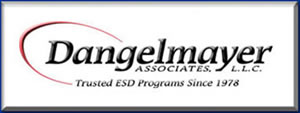Full Range of ESD & EOS Consulting Services: Training, Auditing, CDM, CBE, CDE, Class 0, Cleanrooms, S20.20 Programs
No Product Sales!
Our Services » ESD » Best Practices
Intro | Risk Assessments | Admin Excellence | Requirements | Tech. Expertise | Test Equipment | Training | Manufacturing | Compliance Verification
ESD Best Practices
Introduction
While most companies are acutely aware of the hazards of ESD (electrostatic discharge), few are aware of best practices for preventing failures of today’s extremely sensitive devices often referred to as Class 0 . Virtually all factories will have these devices within the next year. The lack of awareness is due, in part, to the rapid advancements is device technology that make it difficult for standards organizations to keep pace. S20.20 (ANSI/ESD S20.20) is the best industry standard available and is an excellent foundation for best practices ESD programs. To achieve best practices, companies with advanced technologies have found they must customize S20.20 to avoid unacceptable failure rates in the factory and field.
Customization for best practices includes additional requirements and procedures for CDM (Charged device Model), CBE (Charged Board Event), CDE (Cable Discharge Event) and Class 0. Additionally, recent study into the misdiagnosis of EOS (Electrical Overstress) failures suggests that up to 50% of EOS failures are actually ESD damage due to CBE. With this discovery, ESD failures are more pervasive than most realize and have become a dominant failure mechanism on the factory floor and in the field.
The following discussion highlights the administrative and technical requirements for establishing best practices including Class 0 device sensitivities. Dangelmayer Associates specializes in best practices and S20.20 clients have invariably been certified on the first try, clients with high ESD failure rates have virtually 100% yields since working with us, clients with occasional bursts of failures are defect free, clients with EOS failures have seen 80% reductions with the introduction of ESD our controls for CBE (Charged Board Event), and those who have taken advantage of our coaching program have become highly skilled ESD practitioners and technically independent. When measured by accounting, ROI’s have been as high as 950%.
New Product Introduction Risk Assessments
Most companies have formal NPI (New Product Introduction) procedures to verify manufacturing is well prepared for new product designs. However, ESD is seldom included in the NPI process and this has lead to many manufacturing crises. Without the “red flag” for Class 0 devices ESD manufacturing failure rates have been known to approach 100% and caused a virtual shut down of production.
These crises can be avoided by requiring ESD withstand voltages for all new designs as part of the NPI process and it is essential to require both HBM and CDM data. HBM sensitivities are often readily available from device suppliers but it can be very difficult to obtain CDM data. Since it has been reported that CDM failures account for approximately 99% of ESD failures today, this data is essential.
With HBM and CDM device sensitivity information a risk assessment can be triggered for extreme device sensitivities. These risk assessments should include considerations such as a comparison of device sensitivities with manufacturing capabilities or substitution of a less sensitive component. In this author’s experience, the following proposed definition for Class 0 has proven to work well as a “red flag” for many companies.
Proposed Definition of Class 0 ESD Programs: Manufacturing programs dealing with components that have withstand voltages below 250 volts for either HBM or CDM.
Administrative Excellence
Developing, implementing, and managing a successful ESD program requires a total system approach that extends from product design to customer acceptance. The program will need to be well managed and woven into every aspect of the manufacturing process in order to produce lasting success. In fact, a well-managed program can be far more effective than one well stocked with expensive supplies.
This begins with strong management support and commitment to high quality. The ESD program manager needs the resources and flexibility to orchestrate the complexity of a sound program. ESD quality tracking metrics are a must. If you can’t measure the ESD process you don’t have a viable process.
These metrics should include Pareto and trend charts of internal audit results (Figures 1 & 2). This information can be used to identify and resolve problems while effectively leveraging limited resources such as training. For instance, figure 3 shows a Pareto charge that compares the compliance verification performance of multiple departments in one company. This chart indicates clearly which departments need training. So, limited training resources can focus on the departments of greatest need.
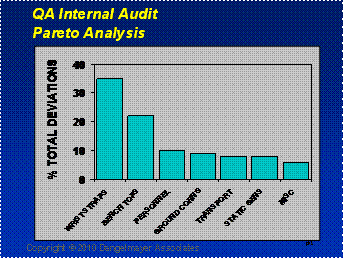
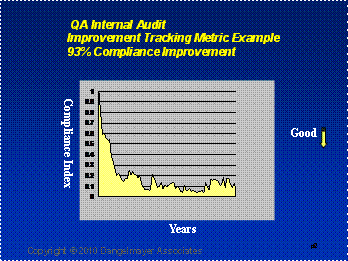
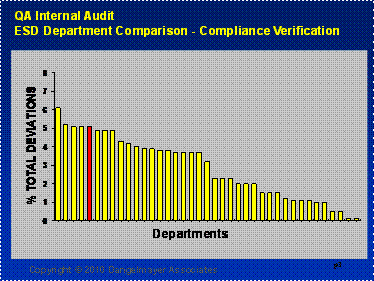
Technically & Administratively Sound Requirements
The ESD control requirements must be technically sound, realistic and formally documented for they are the foundation of the entire plan and they need to be compliant with S20.20. All activities, procedures, and support documents are based on these requirements. See Services » ESD » Documents for more details
It is, therefore, critically important for the requirements to be well documented in easy-to-understand language and mindful of training needs. Furthermore, the requirements must be realistic to be enforceable. They need to include all of the applicable elements of S20.20 plus the best practices presented in this article.
Companies with advanced technologies and Class 0 sensitivities have found they must customize requirements to avoid unacceptable failure rates in the factory and field. Hence, it is unlikely standards bodies will be able to develop a “cook book” approach in the near term. Application appropriate customized procedures will need to be documented by each company.
Technical Expertise
The ESD Program Manager and the ESD team must stay abreast of the technology by all means possible. This includes the EOS/ESD Symposium, advanced tutorials and papers, standards development, and certification such as ESDA ESD Program Manager Certification or iNARTE Certification for engineers or technicians. The ESD team must have a thorough understanding of the technology including mitigation techniques for HBM, CDM, CBE, CDE, and Class 0. For instance, do you know how to customize a manufacturing process to successfully handle devices with 25 volt HBM & CDM withstand voltages? Since standards bodies have difficulty keeping pace with the technology, it is often necessary to draw on the expertise of industry consultants.
The ESD team will need to be well versed in the advanced measurement skills. This includes measurements such as ESD event detection, discharge currents, continuous monitoring of body voltage, charge (Q) on products and the use of the associated instruments. The analysis of Automation equipment is highly complex and few companies have adequate resources including the automation manufacturers themselves. Hence, the ESD team must develop these skills. Event detection is also complex and can be confounded by extraneous background events from a wide variety of sources such as stepper motors. The ESD team must learn how to separate threatening events from background interference.
Test Equipment
Most companies do not have adequate test equipment for the advanced measurements that have become essential. Table 1 lists test equipment that is needed in addition to the basic meters found at most companies and Figure 4 shows the associated resistance probes and their applications.
- Electrostatic Voltmeter – 2 kv maximum
- Continuous Body Voltage Measurement Instrument
- ESD Event Detection Equipment
- Meg ohm Meter
- Capabilities
- Digital Auto Range
- Regulated Test Voltage
- Automated electrification Time
- Surface Resistance Probes
- S11.11 and Mini-Probe
- Two Point Mini-Probe
- NFPA 5 lb probes
- Automated Wrist strap and Footwear Testers
- Door or Turn Style Interlock
- Synchronized with Employee Database
- Exception Reports Sent to Supervisors
- Dual Wire Resistance Monitoring
- 1 Gig Hz Oscilloscope
- Current Probes
- Antennae
Table 1: Advanced Test Equipment (Basic Instruments not Listed)
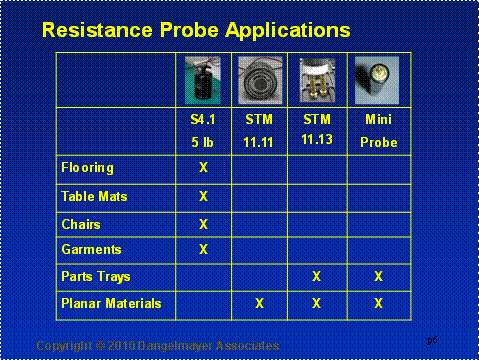
Training
Training must be a primary consideration at all times. A training program built on measurable goals derived from the auditing program allows the process owner to aggressively pursue the identification and resolution of training needs. The auditing results clearly identify when training is needed, who needs training, what needs to be taught, and whether the training was successful.
A blended approach for training is highly effective and includes both instructor lead training and CBT (Computer Based Training). When CBT training is compared with classroom, the metrics show on-line learning saves 50% of total training time and the retention level is significantly better. This works well for operator and moderately advanced training.
The ESD Program Manager and ESD team, however, require advanced training available only from limited instructor lead sources such as the EOS/ESD Symposium, regional workshops, and on-site assistance from consultants. The course material should include all of the elements of the best practices highlighted in this article with emphasis on the two CDM mitigation techniques and advanced measurement techniques.
Manufacturing Handling Practices
Application Appropriate Redundancy becomes increasingly important as device sensitivities fall deeper into the Class 0 category. For instance, there are redundant personnel grounding options that work together to avoid damaging body voltages through either human error or equipment failure. Electrostatic fields and tribo-electric charging can be controlled with ionization and/or humidity controls.
Personnel Grounding is the baseline of defense for both HBM and CDM sources of damage. HBM failures become virtually non-existent when personnel are properly and reliably grounded with redundancy. This can be achieved with constant wrist strap monitors, ESD Chairs, low charging ESD flooring and ESD footwear. The level of redundancy can be based on the sensitivity of the devices as well as the criticality of the product application. Figures 5 and 6 illustrate the value of redundancy. Figure 5 is a 3 sigma body voltage analysis of a person grounded via a constant wrist strap monitor and the 3 sigma voltage was 5.31 volts. The monitor was a dual wire resistance model and the individual was not wearing ESD footwear. Figure 6 reveals a 3 sigma body walking voltage of 37 volts for ESD footwear on conductive low charging rubber flooring. Some companies require the use of both grounding methods for Class 0 as well as flooring that is both conductive and low charging. Low charging conductive floors offer yet another layer of protection from human error or footwear malfunction.
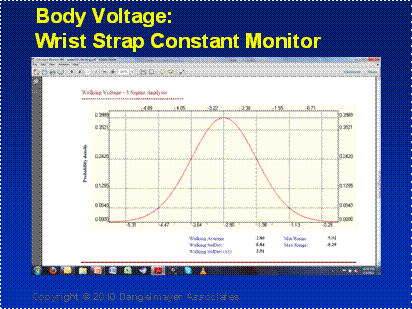
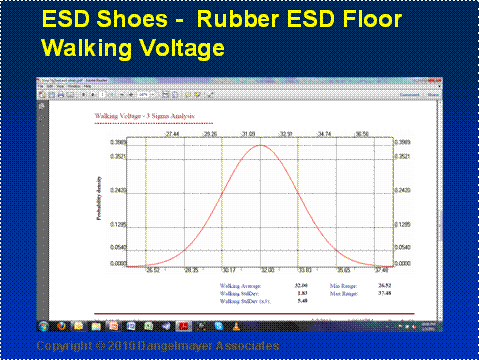
Minimizing Fields and Voltages is one of two CDM mitigation techniques (figure 7) and can be achieved by removing static generators from the work place, with strategic application of ionization, following the 12 rule from S20.20 for essential insulators and with humidity controls. High reliability operations such as defense manufacturing often utilize all of these strategies. It has been demonstrated, however, that Class 0 programs can be virtually defect free without humidity control. Additionally, the strategic application of ionization is more effective than humidity.
The application of ionizers is often overdone and should be based on scientific measurements rather than conjecture. This approach can greatly reduce the number of ionizers without jeopardizing product. With the aid of ESD event detectors and electrostatic voltmeters, sources of ESD discharges can be eliminated removing the need for ionization. Likewise, this approach can confirm when ionizers are effective in preventing the discharge events.
Ionizer selection also needs to be application appropriate. For instance, offset voltages should consistently be less than 1/10 of the CDM withstand voltage of the most sensitive component. Decay rates for the ionizers should be based on measured effectiveness for each application taking into account the manufacturing process speed. For instance, rapid operations may not give the ionizers sufficient time to neutralize the fields.
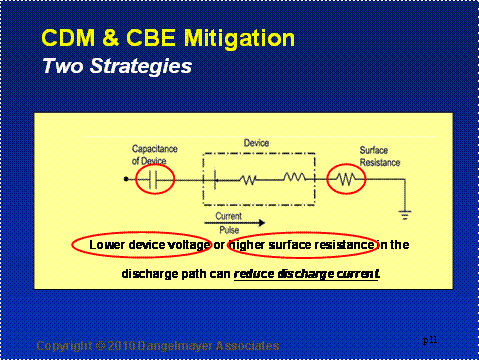
Static Dissipative Handling Materials offer the second means of mitigating CDM damage (figure 7) . This strategy does not preclude the need for minimizing electrostatic voltages but is often more robust. When dissipative materials are positioned at the point of contact with the conductive elements of ESDS (ESD sensitive) product discharge currents are reduced to non-threatening levels. Discreet resistors are not a viable alternative due to the RF nature of the CDM discharge transient. It is also vitally important to minimize, if not eliminate, metal-to-metal contact with the conductive elements of the ESDS product. For instance, static dissipative ceramic tipped tweezers have been proven to reduce discharge currents to safe levels even for TMR heads with ESD withstand voltages between 1 and 3 volts. Table 2 is an example of the reduction in discharge currents resulting from the strategic application of dissipative materials and verification with event detectors. A SOP (Special Operating Procedure) was developed involving contact with dissipative materials prior to insertion in the test fixture. It was also necessary to maintain contact with the dissipative material for a minimum of 3 seconds to reduce discharge currents enough to prevent ESD damage. Device failure currents were measured to be 60 mA and all of the “After” discharge currents were well below this level.
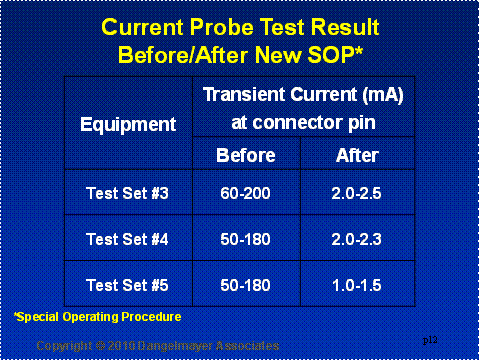
Table 2 – Discharge Current Reduction with Dissipative Materials
Therefore, always specify static dissipative materials when selecting items such as handling materials, tools, tote boxes, and intimate packaging materials or when qualifying fixtures and automated equipment.
Fixtures & Automation Equipment Qualification is highly complex and few companies have taken adequate measures to ensure reliable ESD handling of ESDS (ESD Sensitive) parts and circuit board assemblies. It is not sufficient to assume the manufacturers of automated tools have done a thorough qualification. Additionally, replacement machine parts such as pick-up nozzles for SMT (Surface Mount) tool can introduce ESD problems.
Each manufacturing company will need to develop advanced qualification requirements and verify compliance for new and old equipment. These requirements must include pass/fail criterion for measurements such as ESD event detection, discharge currents, surface resistance, electrostatic voltmeter readings and resistance to ground for stationary and mobile elements of automated tools. Event detection is more complex than many of the test methods but is essential and must be included. A variety of detectors are available that can help to separate threatening events from background interference.
Here is a list of requirements for fixtures and automation equipment.
- All conductive and/or dissipative materials must be grounded.
- Any movement must not result in excessive triboelectric charging of assemblies or components.
- Surfaces that contact assemblies or components must be static-dissipative or, as a last resort, conductive as long as there are no EMI/ESD events.
- The facility and its equipment shall not be subject to ESD damage or malfunction due to ESD
- The equipment shall be equipped with provisions for convenient wrist-strap grounding of personnel and other static control methods. The ground point shall be identified.
- Work surfaces shall be covered with grounded static-dissipative material.
- The qualification of manufacturing test and handling equipment (automated or otherwise) MUST include EMI/ESD testing. No EMI/ESD events shall be detected at a distance of 0.5 meters.
Compliance Verification
Compliance Verification (CV) is the binding force behind a sound program and is critical to a program’s long-term success. Its mere presence spurs compliance and a stronger management commitment that fosters continuous improvement. The four levels of CV listed here enable the ESD Process Owner to manage the program on a scientific and cost-effective basis.
- Annual Technical Assessment
- 3rd Party Audit
- Yield Risk Benchmarking
- QA Internal Audit
- Periodic (determined by company)
- TR53 Compliance Verification*
- Program Administration Verification
- Quality Responsibility
- Statistical Process Control
- Rudimentary SPC
- Daily Process Verification
- Beneficial For Class 0 Sensitivities
- Employee Self-Checks
Many companies have 3rd party audits conducted yearly by their ISO 9000 registrar to maintain S20.20 certification while others have independent authorities perform technical assessments. Both approaches help companies stay abreast of the rapidly changing technology. Yield Risk Benchmarking™ is another valuable tool to compare the quality of an ESD Program with the rest of the industry. Higher benchmarking scores also correlate with higher yields (Figure 8).
The metrics generated by this process provide management with capability to measure and track the ESD program performance of individual sites as well as the corporation’s relative position within the industry.
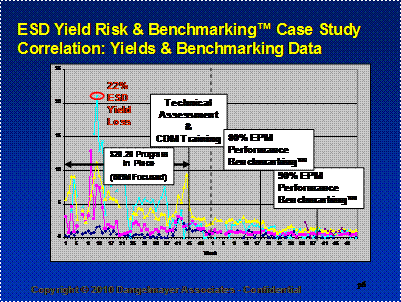
QA (Quality Assurance) Internal periodic compliance verification is vitally important. The factors listed here should be considered to determine application appropriate intervals. For instance, mature programs may not need monthly CV where as new programs would benefit from more frequent feedback.
- Maturity of Program
- Product Sensitivity
- Product Value
- Cost
- Mission-critical Type
- Type Of Process
- Manual Vs. Automated
- Personnel Turnover
- Level Of ESD Control
- Redundancy Etc.
- History Of ESD Issues
ESD TR53 - Compliance Verification of ESD Protective Equipment and Materials provides a solid foundation for all programs but may need to be customized for programs dealing with advanced technologies that require more stringent controls and customization of S20.20. The data derived from sound auditing plans can be highly effective in the early identification and prioritization of process deviations. How the data is reported can have a significant impact on strengthening management support and ultimately compliance. Lengthy reports often go unread where as graphical representation of audit results (figure 9) can have significant impact. Presentation during monthly business results meetings is an effective forum to get managers involved and corrective actions initiated.
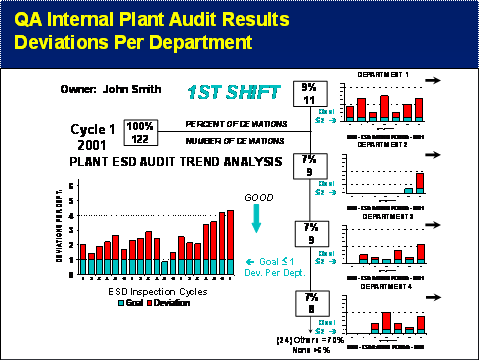
Successful manufacturing with Class 0 ESD sensitivities requires nearly flawless compliance to procedure every day. Administration of such programs is greatly aided by introducing basic daily statistical sampling to provide line supervisors with timely feedback. This third level of CV can be limited to brief visual verification of personnel procedures recorded and tracked as attributes data. For instance, trend charts can alert supervisors to take immediate corrective action to avoid excursions that would lead to high failure levels.
The fourth level of CV is employee self checks that are done at the beginning of each shift and prior to handing ESDS product. Self-checks include items such as testing footwear and wrist strap tests and well as visual verification that the removal of unnecessary static generators, application of the 12 inch rule for essential static generators and visual verification of bench ground wires.

